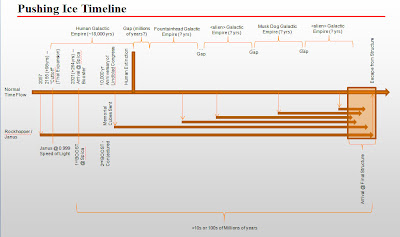Reader Clay Hunt produced this fantastic schematic of the timelines in Pushing Ice. In Clay's words: "When I got to the point where Bella touches the Memorial Cube and starts figuring out JUST HOW FAR into the future they have traveled, it BLEW my mind." This is Clay's attempt at figuring out the basic chronology of Bella and Svetlana's journey into deep time. Clay wonders if it's correct, and my truthful answer is that it could well be, but I'd need to re-read the book to be sure. In the meantime it looks pretty damn excellent, doesn't it? I'm a sucker for these things, and I'm knocked out that someone considered it worth their time to produce one for my story. Thanks, Clay.

Click to embiggen. If any of you have any thoughts on the timeline, I'm sure Clay and I would enjoy hearing them.


The "deep time" of Pushing Ice was one of the things I liked best about it.
ReplyDeleteBrilliant stuff, thanks for sharing!
ReplyDeleteIncredible. Very cool indeed.
ReplyDeleteMind blown.
ReplyDeleteSomething I never got was how come the cube has left humanity 20000 years after RockHopper but somehow got to the Structure before it? Even though RockHopper was boosted to incredible speeds? Was the cube even faster? Even then, considering they only had a vague idea of the direction to search for, how unlikely is that one of the cubes actually found the destination before Rockhopper?
ReplyDeleteRockhopper was kept in a holding pattern (orbiting the galaxy, or something), so lots of time elapsed even without travelling megaparsecs in a straight line. The idea is that all the different species would have arrived at the Structure at around the same time, give or take a few 1000s of years. Enough cubes were thrown out such that one or more were bound to end up at the Structure.
ReplyDeleteWell done Clay! The timeline would make a great addition to the book if for the fact that it would give away a mind-blowing spoiler. Pat on the back Dude!
ReplyDeleteThat is a great timeline - I haven't read it in a while myself. I do recall having a few timeline questions though. I'll reread it and refer to the timeline and see if that answers them all.
ReplyDeleteDefinitely makes me want to read the book again.
ReplyDeleteThis just elevated my lunch break from 'good' to 'awesome'.
ReplyDeleteActually, I don't think (based on the story) that one can make ANY conjectures on the timescales/durations/locations of any of the main protagonists, except to say they (in the case of the Fountainheads) had knowledge of humanity independent of their time in the Structure.
ReplyDeleteI didn't read the post because I'm currently in the middle of Pushing Ice for the first time, and didn't want any spoilers. I work as a technical translator from Japanese to English and I take breaks and read a bit of something else to clear away all the linguistic clutter in my brain. Well, I just read the scene of Mike Takahashi's death, and closed the book with a ball of ice in my stomach. Workaday clutter thoroughly cleared.
ReplyDeleteMission accomplished, Mr. Reynolds.
The timeline looks nice, although I have to say based on my reading of the book, it's not given whether the Musk dogs and other aliens actually came after humans and the Fountainheads. It's entire possible that the Musk dogs predated the human galactic empire.
ReplyDeleteThe time line didn't make it clear and the book didn't either, it's not for sure if the humans became extinct that soon after 18,000 years. Of course it's up to Alastair to decree when that occurred, but for all we know, humanity lasted for millions of years before kicking the bucket.
One thing I've always wondered is if the Final Structure is within the Milky Way galaxy(or what's left of it after eons) or somewhere else.
I imagine the Foundationheads were terribly disappointed to find such a primitive group of humans from very early in the history of the human empire instead of the advanced humans they probably were expecting to find. It certainly brings up an intriguing idea that the Rockhoppers won't be the only human group to hitch a ride to the Final Structure.
I finished reading PI for the first time a few days ago, and when the characters realized how many millions of years in the future they were stranded, it felt like a kick in the nuts. I felt like I was there with them, and that soul-crushing expanse of time and distance was mesmerizing. No one does that feeling of cosmic isolation better than Alastair in my opinion. It had the exact opposite effect of the massive stretches of time in House of Suns. Those stretches, while audacious, made me marvel at the posthumans, whereas these just made me feel small. I'd love to see a sequel someday! (To both novels, really)
ReplyDeleteThis was a fascinating book, one of my favorites of the genre. The time line is great and Alastair's explanation of the holding pattern makes a lot of sense about various elements of the book now. I do hope you write a sequal.
ReplyDeleteRegards
David Conyers
We really do not know many galaxies and how long a time the system of collecting the samples actually spans, or what are the relative timelines between the species. What really hit me on this book was that the universe is not only vast, but old. The relativity of time and space was presented nicely and in a concrete way.
ReplyDeleteI hope we do not see a sequel. The story is complete as it is.
The story was left incredibly open ended. You can do SO much with a sequel to PI. Phenomenal book, top 3, reading it again now.
ReplyDelete